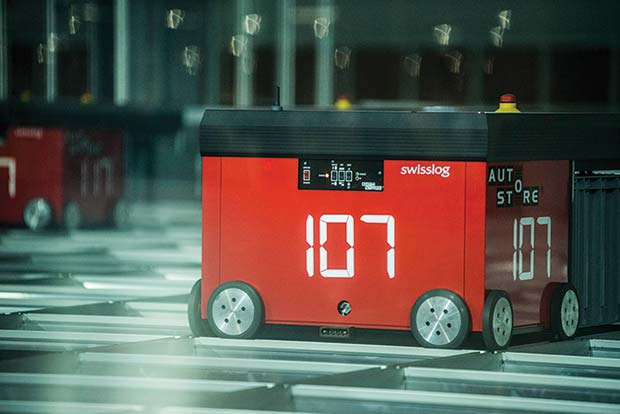Many customers today would not want to miss the convenience of shopping at the click of a button. But not every retailer has been able to successfully manoeuvre the pitfalls of doing business online.
James Sharples, Managing Director of Swisslog, shares his thoughts on the logistical issues impacting today’s retailers:

What have you found are the major issues facing retailers this year?
Retailers, whether online, offline or omni-channel, are generally on the lookout for a competitive advantage from their logistics. As omni-channel operations have become the new norm, and customer expectations of next-day and even same-day delivery are continuously raised, the challenge is to get as optimum an operation as possible.
How have you found the demand for new solutions from retailers this year?
We see a high number of enquiries for intralogistics solutions, particularly from retail and e-Commerce businesses. This remains a buoyant market where operational efficiencies can be clearly achieved through the implementation of well thought out materials handling solutions.
Does there appear to be more investment in materials handling solutions online or offline?
Overall investment appears to be balanced across the channels, and often we are working with customers regarding strategies to accommodate both simultaneously. While there is certainly a buzz around solutions for online order fulfilment and we see many rising e-commerce stars wanting to take their logistics to the next level, solutions for traditional retail channels still need optimising or often overhauling to take advantage of efficiency gains from latest technologies.
![CarryPick-2[4]](https://warehousenews.co.uk/wp-content/uploads/2016/08/CarryPick-24.jpg)
Many omni-channel retailers are struggling to make a profit with their online business, have you any thoughts on why this is?
Successful e-commerce players have managed, in time, to get away from static approaches heavily tied to fixed costs. It’s also apparent that these companies took measures very early on to lower their distribution costs and to achieve a high level of delivery accuracy and short delivery times. For omni-channel retailers, the struggle may be with their warehousing not being optimised to keep up with the demand from both an online and offline audience. Consumers are also becoming accustomed to paying very little, if anything, for the delivery of their items, which can put some e-commerce and omnichannel retailers out of pocket.Returns is also a major factor that can eat away at retailers’ profit margins, especially for online businesses.
How are returns effecting profit margins?
The consequence of handling returns is often not fully appreciated by retailers, particularly to new e-tailers. Even a sought after retailer can experience returns of 20 to 30 percent of shipped items, all pushing up inventory value and putting a strain on the cash flow. To compete in today’s market, retailers are offering free returns. If a lot of people choose to buy from a certain website because the returns process is so easy, that can become a driver in the market, but it’s a double-edged sword. You get more customers because you offer a really good returns policy, but you are going to get more returns off the back of it. It’s a zero-sum game between customer and retailer.
What other success factors are playing a role?
One of the most important factors is the speed of delivery. Same-day delivery is no longer just a catchphrase; it’s something that more and more online shoppers expect. Rapid and most importantly, accurate, order fulfilment in the warehouse or distribution centre is therefore critical. In addition, intralogistics solutions must offer the necessary degree of scalability to handle seasonal fluctuations. Quite a few retailers have experienced delivery bottlenecks during such peak periods. This is detrimental to their image and can deter repeat customers.
Finally, it is important that an intralogistics solution is flexible and able to adapt to a constantly evolving product range. Have you any advice for retailers and e-tailers looking to accommodate peaks within their supply chain?
While previously, peaks would be mostly (and more simply) related to seasons, festivities, milestone events such as ‘Back to School’ or climate related, they are now much less predictable. Enhanced online visibility, not only on price and quality comparison sites, but also of celebrity endorsements, hottest innovations, new releases and latest fads are not helped by an increasing trend of consumers expecting same/next day delivery.
I am sure, for example, that electronics providers didn’t predict a rise in demand of backup batteries for PokemonGo gamers! My best advice to those looking to accommodate peaks would be to view the changing retail landscape as an opportunity, not as a threat, and invest in their operation accordingly.
My best advice to those looking to accommodate peaks would be to view the changing retail landscape as an opportunity, not as a threat, and invest in their operation accordingly.
How will Industry 4.0 impact this?
Industry 4.0 is the idea of ‘smart warehouses’ in which machines are optimised with internet connectivity, allowing a system that can make decisions on its own. Not only will it provide increasingly clever automation technology for accommodating peaks, Industry 4.0 works hand in hand with big data so will continue to enhance the level of intelligence within the warehouse / DC to benefit the entire supply chain.
How can automation be used to facilitate this?
It is critical to note that automation has to be used wisely in order to be effective. Here, the value of consultancy cannot be stressed enough. Whether for a new or existing facility, we naturally find that we design our best intralogistics solutions once we have sat with customers to really dig into their current operation and also understand where they are planning to go in the future.
Through a thorough data analysis and deep understanding of customer needs, we are able to offer solutions that really make sense – that way, our customers can clearly see what is proposed, why, and the value it will bring to them.
We might conclude, from a quick discussion, that automation isn’t the right approach for a particular retailer. We may propose ‘islands of automation’ to some, while to others a fully integrated automated solution will make perfect sense – but this decision should be an educated one. We should also be mindful that there are various levels of automation and ultimately, retailers need to look out for speed, accuracy and agility.

We hear a lot about Automated Item Picking (AIP) – are robots ready to take over?
The best value from robots are when they are working collaboratively with operators. We call them collaborative robots, or cobots. They work directly side by side human operators to assemble an efficient warehouse operation. That said, we also see a lot of interest in our high-speed autonomous robot picking, and DHL has already stated that robots will soon be standard in their warehouses.
How has 2016 been for Swisslog generally?
It has been a very strong first half of the year for Swisslog, with the launch of the new CycloneCarrier shuttle storage and transport system, which moves cases quickly and safely for improved warehouse efficiency. We also recently announced the acquisition of Power Automation Systems (PAS), the worldwide market leader in pallet shuttle AS/RS. Many new customers have been added to our portfolio too, as interest in automated material handling solutions is increased as a lever to drive efficiency throughout the supply chain.
Have you any thoughts on how Brexit will impact Swisslog?
As part of the KUKA Group, Swisslog has a global reach and many customers, employees and operations both within and without the European Union. While Brexit is a turning point in UK political history, we do not expect a radical change in our approach to the market and note that the UK itself is used to dealing with challenges and changes in a rapidly evolving business sector, such as ours. There may be economic challenges for British companies further down the line, but the indications are encouraging that organisations will continue to invest in their future. While we expect a delay of investment projects due to the uncertainties of our customers regarding their future in the short term, heightened focus on intralogistics, as a requirement of agile and efficient logistics infrastructure, will undoubtedly become even more important thereafter. Swisslog has consistently emphasised the scalability and flexibility of our automation solutions, and those capabilities will help those that are already in partnership with us. Those that take this period of instability to hold off on capital investments may lag behind their competitors. At the very least, such businesses can benefit from maintaining optimum availability at their existing operations through our onsite support services. We’re witnessing a revolution in the retail industry…

What’s at the heart of this change?
• A change in the way people are shopping / rise in e-Commerce / m-commerce
• Rising consumer expectations
• Increasing seasonality & Unpredictable peaks For the warehouse, this means: • A reduction of Click to Delivery times
• High Average-Peak Ratio
• Increasing Rate of Returns
• Increased handling of Small Item Goods Unpredictability is the new normal for retailers… … and at Swisslog, it’s our job to provide the right solutions to make their warehouse operations run smoothly…
SWISSLOG (UK) LTD
Tel: 01527 551 600




Comments are closed.